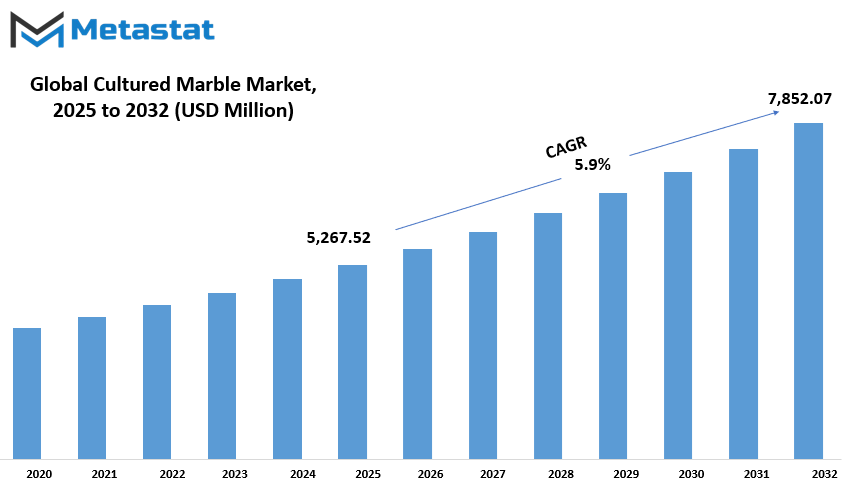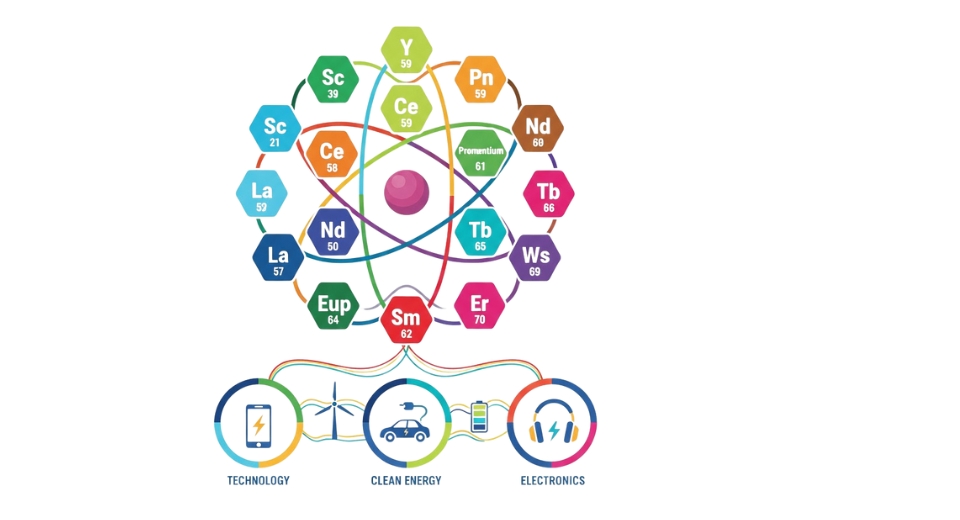MARKET OVERVIEW
The cultured marble market is distinct and thriving, even within the larger spectrum of engineered stones-their qualities make it a cross-section of beauty and utility. Indeed, as with progress in material sciences, a cultured marble is quite an example proving human inventiveness, narrowing the gaps between natural elegance and modern technique in production. It has always been capable of realizing, or at least imitating, the luxurious appeal of marble while outperforming the latter in resistance: this industry has really gone beyond the limits of application one could have normally expected.
Cultured marble has been accepted in architecture for years - countertops, vanities, and flooring, but it's creeping into some new places now. For instance, in a transforming interior space, this material isn't just for surfaces that serve a purpose, but interior designers' imaginations are running wild, and their explorations are expanding into unique installations and custom furniture pieces, even including sculptural elements that reshape the feel of a space. This design is already penetrating hotels, corporate offices, and luxury homes, raising the level far beyond utility alone. Cultured marble continues to push back boundaries of creative potential with metals, glass, and other composite materials.
It has also paved ways for cultured marble in the industries that were for years historically dominated by traditional materials paving into the future of engineered stone technology. The automotive and aerospace industries, known to concentrate on weight savings but high-strength applications, have turned their attention to what cultured marble could offer. And as research advances, the future will likely see false-form application for cultured marble as non-structural vehicle components for motor cars and as such in the interiors of aircraft cabins. Durability, weight efficiency, and cost-effectiveness work together, driving this emerging trend, making it interesting for manufacturers continuously scouting for superior alternatives to their traditional composites.
Although not much of the Global Cultured Marble market as yet has been touched by green construction, the few pages being written are those still-increasing demands for green materials, setting innovations in production methods-referring to cultured marble products that contain recycled content and lower carbon foot-prints. Sustainability has etched its marking into most economies today, but engineered stone is now joining the fray with responsible sourcing, energy-efficient manufacturing, and reduced waste strategies. The transition will not only be limited to residential and commercial spaces but may well extend to infrastructure developments with a green building thrust.
Global Cultured Marble market is estimated to reach $7,852.07 Million by 2032; growing at a CAGR of 5.9% from 2025 to 2032.

GROWTH FACTORS
The Global Cultured marble market is growing rapidly which stimulates the development of commercial and residential construction projects worldwide. End-users and industries seek an affordable yet durable replacement to natural marble, which they find in cultured marble. The versatility offered because of its aesthetics; with these advantages, it comparatively needs lower maintenance, and thus it is fast capturing big markets. Demand for cultured marbles is growing among homeowners and contractors because they are looking for the same elegance offered by natural stones, which usually come with high costs and complex maintenance concerns. It is not only a closely resembling appearance replica of natural marbles, but it also provides better durability while enhancing moisture and stain resistance. Expansion in urbanization and constructing more infrastructures have indeed seen cultured marbles becoming more common in bathrooms, countertops, and floors.
In spite of growing acceptability, however, there are massive challenges associated with the market. One of the major drawbacks has competition from natural stone and engineered quartz products. Marble's unique pattern and perceived luxury make it unfavorable because most of the end-users want to have their marble. Besides, artificial quartz provides the same advantages, making it widely known, particularly because it offers better durability and design. Environmental issues with resin-based composite materials used in cultured marble end up being another drawback. In calculating sustainability in the future, which is a key focus of the construction industry, these things would mean addressing them to remain in competition. Efforts are still going on the development of eco-friendly resins and manufacturing processes, although the significant issue remains large concerning environmental scrutiny.
However, with all these constraints, the industry paves bright prospects. Many potential customers are trending toward sustainability; hence their need for greener and innovative alternatives for projects is increasing. Manufacturers are now looking at using recycled materials and bio-based resins to create cultured marble that will be in line with the global sustainability trend. Innovations in technology have also been improving the quality and texture of cultured marble as well as the understanding of its aesthetics, making it much more appealing for high-end residential and commercial applications. The market expansion also owes much to customization since customers are looking for unique designs that would cater to their specifications.
So, as the industry progresses, companies might invest in new research on sustainable innovations to gain an edge in competition. With continuous improvement in manufacturing techniques and material composition, cultured marble is likely to entrench itself further as a preferred alternative in modern construction and interior design.
MARKET SEGMENTATION
By Composition
The Global Cultured Marble market is garnering interest across industries as they have immense applications and attractiveness. Cultured marble is a synthetic product and has become popular for residential as well as commercial applications due to its durability, price, and look alike with natural stone. Unlike natural marble, which is quarried, processed, and priced heavily, cultured marble is made from a mixture of resins, pigments, and crushed stones and hence is seen as a sustainable alternative for customizable design. Increased use in bathrooms, kitchens, and other decorative spaces gives rise to the material's demand, where owners and builders alike prefer a cost-effective yet pleasing solution.
The further driving factor of this market is the increasingly growing preference for materials that endure long and last with low maintenance. Cultured marble is a very suitable option for high-traffic areas because it stands stains, scratches, and moisture. The seamless design minimizes the risk for mold growth, thus making it even more interesting for modern constructions. The latest technology advancements have made it possible for a manufacturers' quality finish to resemble natural marble closely, giving an elegant appearance without incurring costs related to quarries and fabricating goods. This makes things very affordable and offers good versatility in aesthetics, thus finding its application in all forms where private remodeling is involved to gigantic commercial developments.
It promotes the increasing awareness of consumers to use and choose sustainable construction materials, which impact the market as the environmental concerns raise against the trends in producing even eco-friendly production processes that minimize the waste throughout the production process and also reduce carbon footprints. Cultured marble production with the help of recycled materials becomes one of those options that fit within the framework of the global sustainability agenda, thus being a favorite among environment-conscious purchasers. Also, government regulations induced by the sustainability argument for constructing and building promote alternative choices in construction materials that add momentum to the development of this market.
Cultured marble is categorized into different modalities, such as cement-based, composite, and polyester. Cement-based cultured marbles are estimated to account for a large market share. The share of cement-based cultured marble stands at $671.10 million due to its robustness and versatility in construction applications. Even composite and polyester-based types are gaining traction as they provide extreme flexibility and lightweight properties needed in modern architecture. As developments in material science progress, such compositions will undergo further development for a broader appeal while making further inroads across various industry sections.
After that, the Global Cultured Marble market will likely continue to grow in the future while industries continue to invest in research and development to improve product quality and widen the application areas.
By Application
With the growth of industries increasingly recognizing the benefits gained from these types of materials, the cultured marble market is gearing up for an upward turn. Durable and attractive cultured marbles are preferred materials for use in residential and commercial spaces. The market segmentation on account of its application is for vanity tops, single wash basins, double wash basins, bathtubs, shower walls and surrounds, and other customized applications. Each application is critical to the interior design component, providing function as well as style.
Vanity tops from cultured marble are popular in homes, hotels, and commercial buildings because they look seamless and water-and-stain-resistant. Unlike natural stone, it is more affordable in cost yet maintains elegance. Single wash basin and double-wash basins have also gained more demand, especially with the trend in urban housing projects or luxury accommodations. Such basins offer considerable flexibility of design as they can be customized in terms of size, shape, and color to suit different interior themes.
Bathtubs of cultured marble form another very important segment in the market. This type of material has very high heat retention abilities resulting in a really enjoyable bathing experience that spells out why it is preferred among homeowners and spa facilities. It is also noticeable that shower walls and surrounds, made by cultured marble, give a very modern, sleek look with great durability. Their non-porous surface also provides easy cleaning and maintenance, with reduced chances of mold and mildew formation. Besides major applications, the subject of study further broadens its market scope through some custom projects, including but not limited to countertops, wall panels, and decorative applications.
As industries continue to delve into unique innovations in developing the aesthetic aspect of interiors with effectively affordability, the cultured marble edge would only get sharper. Most manufacturers are developing and enhancing production methodologies for improved quality, sustainability, and flexibility in design. The increased interest of consumers in eco-friendly alternatives will pave the way for future innovations in the market for recycled and lower emissions cultured marble products. All these ensure that cultured marble remains competitive against all other cost-effective materials in its durability and aesthetic appeal within construction and interior design. The growth in real estate, hospitality, and commercial infrastructure will propel the market, giving additional life to cultured marble as a modern material in architecture.
By End-Use
The ongoing development that has been taking place within the Global Cultured Marble market is that industries moved from natural stones to more high-quality and cost-effective alternatives. What drives this market is the quest for aesthetic and durable materials on outdoor and indoor spaces for residential as well as commercial. Much more, cultured marble would give a practical solution towards mimicking natural stone while implementing enhanced durability and lower maintenance requirements. This market would be growing as builders, designers, and homeowners start realizing this fact.
This often-used application of cultured marble is in construction purposes mainly found on countertop or vanity tops, shower walls, and other interior applications. The main segment of the market therefore is end use, such as new construction and renovation projects. For instance, in new constructions, architects and builders are using cultured marble into modern designs just to bring out the desired visual effects that look sleek and luxurious without fetching high costs that come with naturality. Most common these applications are among high-rise buildings, hotels, and commercial complexes, particularly in terms of beauty and durability.
The money spent in renovation projects greatly leads to the growth in this market because homeowners want economic ways to freshen up their interiors. Home remodeling—especially in bathrooms and kitchens—is enlarging the market for cultured marble products. This surface is almost entirely resistant to water and staining and, because of that; it is perfect in all areas frequently exposed to moisture and used daily. In addition, seamless installations also minimize time and labor, which attracts renovation professionals and homeowners alike.
Manufacturers in the Global Cultured Marble market are continually on the run to improve the quality of their products and the variations in their design to suit the changing needs of consumers. Advances in manufacturing technology have enabled the production of cultured marble with improved color consistency, pattern variations, and even improved surface finishes. As sustainability is becoming increasingly important, companies are also concentrating on eco-friendly production processes, applied recycled materials, and reduced carbon footprints to maintain compliance with environmental standards.
Market players have also extended the reach of their distribution networks to include local and international coverage for their markets. Also, with the help of several e-commerce platforms and direct-to-consumer sales channels, cultured marble products become even more accessible to customers. Such channels allow customers to browse products from different brands and manufacturers from the comfort of their homes.
Bright as the future holds, so strong is the combination of innovation, consumer awareness, and economic factors driving the further growth of the Global Cultured Marble market. Thus, the market will have steady advancements in the coming years, for it strengthens its footings with a growing focus on affordability, aesthetics, and sustainability.
|
Forecast Period |
2025-2032 |
|
Market Size in 2025 |
$5,267.52 million |
|
Market Size by 2032 |
$7,852.07 Million |
|
Growth Rate from 2025 to 2032 |
5.9% |
|
Base Year |
2024 |
|
Regions Covered |
North America, Europe, Asia-Pacific, South America, Middle East & Africa |
REGIONAL ANALYSIS
Geologically, the Global Cultured Marble market has been divided into major regions of North America, Europe, Asia-Pacific, South America, and the Middle East and Africa. Each region is further divided into separate territories for the distribution of markets and potential growth areas.
In North America, cultured marble demand has continued to increase in the U.S., Canada, and Mexico, having applications in residential and commercial sectors. Europe leads in terms of market Influences like the U.K., Germany, France, Italy, and others. Their gradual acceptance of materials that are easy on the eye and easy on the pocket continues to hold the market afloat in this region.
Asia-Pacific, on the whole, molds a prime space for the cultured marble industry in India, China, Japan, and South Korea. The nations are embracing modernization and construction activities at a fast pace, thus making the acceptance of cultured marble products even more worthwhile the investment. The rest of the Asia-Pacific region offers this market a lift with increasing disposable income and a change in consumer trends.
South America comprises Brazil and Argentina due to the real estate and hospitality sectors pushing the actual market. This then leaves the Middle East & Africa, which is fragmented into GCC Countries, Egypt and South Africa, from where the rest of the region is further put together for easy marketing. The cultivation of interest in cultured marble through these regions is being fired by the increasing attention paid to modern infrastructure and premium applications for interiors.
Geographical segmentation of the Global Cultured Marble market facilitates the companies to grab the regional trends and modify their strategies accordingly. The existing economy, technological progress, and ever-lapping consumer tastes will serve to ascertain that the stakeholders are updated with recent change.

COMPETITIVE PLAYERS
The Global Cultured Marble market is moving at an increased pace owing to the upsurge in demand for surfaces that are durable, cost-effective, and aesthetically appealing for both residential and commercial applications. Cultured marble is an alternative to natural stone, created by combining natural marble dust with resins and pigments; it is supposed to keep the image and feel of marble while being less expensive and of greater ease of maintenance. It finds its application in bathroom vanities, countertops, bathtubs, and wall panels, and its durability and style go a long way with both homeowners and businesses.
With accelerated advancements in manufacturing, improved products with high durability, interesting designs, and the use of eco-friendly materials are being developed. Urbanization, increasing disposable income, and a gust for chic home and office interiors are driving steady growth for this market. Cultured marble is strategically in use in many projects in several industries, including construction, hospitality, and real estate, due to its water and stain resistance and long-lasting performance.
The industry leaders are targeting innovation and sustainability, providing flexible designs that appeal to the ever-changing consumer preferences. The Marble Works, American Marble Industries, Rynone Manufacturing Corp., and Virginia Marble Manufacturers, Inc. are admired for their high-quality products and commitment to excellence. Meanwhile, other key players, including MarCraft, Inc., Hangzhou Nabel China Co., Ltd., and Kingkonree International Surface Industrial Co., Ltd., have embarked on establishing integrate R&D facilities toward developing new patterns and textures to echo the beauty of natural stone.
Environmental concerns are also responsible for pushing cultured marble manufacturers to be involved in sustainable procedures and use materials that will curb their carbon footprints. Many companies have already implemented eco-friendly methods of production with no waste generation, using recycled materials to meet the increasing awareness of eco-friendly products.
A shift in consumer preference toward visual appeal and versatility has set an immediate platform for architectural cultured applications in both residential and commercial projects. Furthermore, with the technological developments enhancing manufacturing processes, further expansion is anticipated, with companies eagerly marketing themselves with better products and customer service. The Global Cultured Marble market has a well-foreseen future since it is adapting to the demands of the current trends and consumer expectations, making it a more favorable choice for modern designing.
Cultured Marble Market Key Segments:
By Composition
- Cement
- Composite
- Polyester
By Application
- Vanity Tops
- Single Wash Basins
- Double Wash Basins
- Bathtubs
- Shower Walls and Surrounds
- Other
By End-Use
- New Construction
- Renovation
Key Global Cultured Marble Industry Players
- The Marble Works
- American Marble Industries
- Rynone Manufacturing Corp.
- Carolina Custom Surfaces
- Virginia Marble Manufacturers, Inc.
- MarCraft, Inc.
- Hangzhou Nabel China Co., Ltd.
- Sand & Swirl, Inc.
- Kingkonree International Surface Industrial Co., Ltd.
- Huber Engineered Materials
- Williams & Sons Cultured Marble
- Xiamen Byroca Industries Co., Ltd.
- Patrician Marble Company
WHAT REPORT PROVIDES
- Full in-depth analysis of the parent Industry
- Important changes in market and its dynamics
- Segmentation details of the market
- Former, on-going, and projected market analysis in terms of volume and value
- Assessment of niche industry developments
- Market share analysis
- Key strategies of major players
- Emerging segments and regional growth potential








 US: +1 3023308252
US: +1 3023308252






